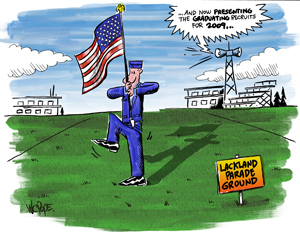 |
(Illustration by W.C. Pope) |
Does the Air Force want to shrink to an active duty end strength of 316,000 airmen, or does it actually want to expand to 330,000 troops
The answer is: Yes.
In Feb. 27 testimony before a House committee, Secretary of the Air Force Michael W. Wynne said, “I must stand by the 316,000” figure in USAF’s budget request. A few minutes later, he declared, “We really would prefer to hedge our bet at 330,000.”
At which point Chairman Ike Skelton (D-Mo.) sighed, “I kind of feel like Mark Twain, [who once said], ‘The more is explained to me, the more I don’t understand it.’ “
He’s not alone. We know that USAF today has 329,000 airmen. Whether that end strength is going up or down, though, is a topic snarled in the arcana of federal budgets and Pentagon politics.
Wynne himself is not confused. Far from it. He is simply trapped by what he officially must say.
Where did 316,000 come from? At the end of 2004, USAF had 376,600 actives. Service leaders, desperately seeking funds to support recapitalization, laid plans to cut 60,000 airmen, leaving 316,600. The last increment of 13,000 airmen was to go in 2009.
Since then, however, demands have held steady in all areas and actually increased in some. Even with reorganizations, AFSO 21 process improvements, base closures, and other efficiencies, a force of 316,600 airmen is too small.
Therefore, USAF’s top officials no longer endorse the planned personnel cuts. The problem is that the service continues to be bound to the Bush Administration’s budget, which uses the 316,000-troop target. “I must support the President’s budget as it was submitted,” Wynne said, adding that, in his “personal opinion,” it would be better to halt the cutting and instead boost the number of airmen. Similarly, Gen. T. Michael Moseley, Chief of Staff, testified that “this is an affordability issue,” and “while we support the President’s budget, we’re working hard inside those fiscal limits.”
Even as USAF defended the President’s budget, it sent to Congress an “unfunded requirements” list containing a request for $385 million in 2009 to expand active duty manpower to 330,000 airmen.
A recent USAF report to Congress noted that 316,600 airmen would leave the service staffed at only 96 percent of requirements in 2009 and at an average of 95 percent through 2015.
This shortfall was calculated using sophisticated manpower tools to determine the number of airmen needed. The shortfall will have a “significant impact” on USAF’s ability to perform its missions and will create “critical” capabilities gaps, the report states.
Increasing operating tempo could cause large numbers of airmen to start “voting with their feet” and exiting the service en masse. An immediate combat concern centers on a looming shortfall of roughly 5,300 airmen in the aircraft maintenance and munitions career fields. The units dependent on these front-line airmen, critical to generating Air Force combat power, have traditionally been fully staffed. The requirement for maintenance and munitions personnel is increasing because old aircraft are flying and breaking more.
The cuts were also planned under the assumption that USAF’s ground force taskings would end, but the Air Force now has 6,200 airmen performing land force jobs.
Because of the President’s budget topline, the need to prop up modernization and recapitalization accounts, and various Congressional restrictions on retiring old aircraft, the Air Force cannot find the money to solve its manpower problem on its own. Maintaining end strength within the existing budget would require USAF to close 15 major bases—an idea that is obviously a nonstarter. The problem will only grow worse. The budget asserts that end strength will remain at 316,600 for years to come, but the need will continue to grow—from 330,200 airmen in 2009 to 335,700 airmen in 2015.
Why? The missions keep expanding. US Africa Command and its air component will need airmen, as will Cyber Command. The Air Force will add four wings of Predator and Reaper unmanned vehicles and a new Global Hawk reconnaissance UAV wing.
Also on the horizon is the CSAR-X rescue helicopter fleet, which will add a net of 40 aircraft to the CSAR inventory. The F-35 fleet is similarly forecast to be larger than the combined F-16 and A-10 fleets it replaces.
The Army and Marine Corps, meanwhile, are moving in the opposite direction, adding a combined 92,000 troops. More soldiers and marines will require battlefield airmen to travel with them, and Air Force lift to move them. USAF is building a battlefield airman wing to support a larger Army.
All told, USAF’s report finds a shortfall of nearly $12 billion in personnel accounts through 2015. Unless additional airmen can be brought into the mix, and soon, the manpower shortfall will continue to grow—with resulting damage to combat power and national security.
More information: Review of Air Force End Strength